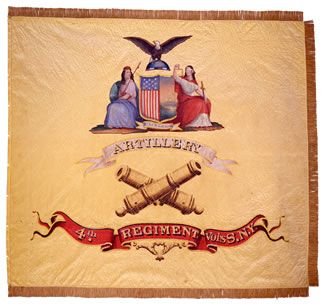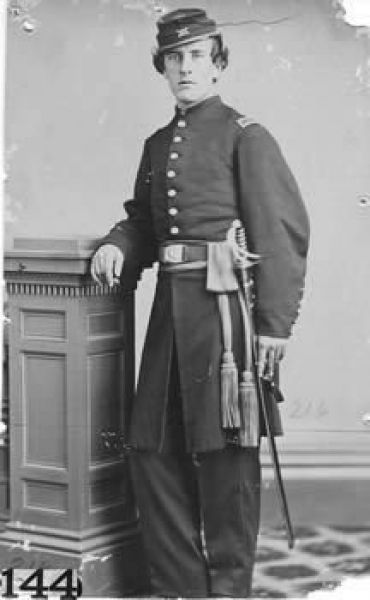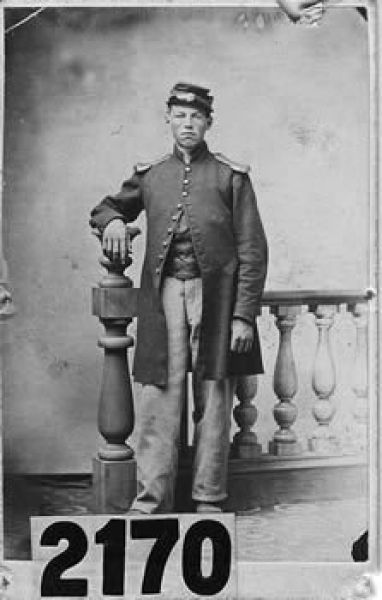4th Heavy Artillery Regiment
Mustered: in November 1861 to February 1862
Mustered out: September 26, 1865
The following is taken from New York in the War of the Rebellion, 3rd ed. Frederick Phisterer. Albany: J. B. Lyon Company, 1912.
November I, 1861, Col. T. D, Doubleday received authority to recruit a regiment of heavy artillery. This regiment, originally known as Doubleday's Heavy Artillery, was designated the First Heavy Artillery January 27, 1862; and the Fourth Regiment of Artillery, February 8, 1862. Two companies intended for the United States Lancers were attached to it. It was organized at New York city, and the companies were mustered in the service of the United States for three years, at Port Richmond, S. I., A and B in November, 1861; C in December, 1861; D, G and H in January, 1862; and E and F in February, 1862, eight companies being organized only. Company G was consolidated into Company H, February 8, 1862, before leaving the State; a new Company G joined the regiment in October, 1862, at Washington, D. C., where it was mustered in the United States service for three years, October 25, 1862. July 25, 1863, orders of the War Department attached the four companies of the 11th Artillery, A, B, C and D, to the 4th Regiment as Companies I, K, L and M, respectively, and these companies joined the regiment October 16, 1863, completing the regimental organization. At the expiration of the term of service of the original seven companies, the men entitled thereto were discharged and the companies retained in the service, B and D being reorganized from recruits joining the regiment at the time. June 5, 1865, the enlisted men of Companies G, H, I and K, 8th Artillery, of the 111th, 125th and 126th Infantry, not mustered out with their regiments, joined this regiment by transfer.
The companies were recruited principally: A, U. S, Lancers, at New York city, Groton, Brewster, Dykeman, Pawling, Schenectady, and Paterson, N. J.; B, U. S. Lancers, at Brooklyn, New York city, Gilboa, West Troy and Blenheim; C at Rochester, Scottsville, Oswego, Hornellsville, Canisteo and Mumford; D at Ballston Spa, West Day, N. Greenwich, Port Richmond and Northville; E at New York city, Port Richmond and Cohoes; F at New York city and Staten Island; G and H at New York city, West Day, Edinburgh, Port Richmond, Brooklyn, West Troy, Groton Falls and Rochester; I at Rochester, Buffalo, Batavia, Waterloo and New York city; K at Rochester, Buffalo, Oswego, Niagara, Brooklyn and New York city; L at Rochester, Utica, Nunda, Le Roy and New York city; and M at Canandaigua, Geneva and Rochester; second Company G at New York city and Rondout. The men of the second Companies B and D were recruited principally: those of B at New York city, Troy, Gilboa, Auburn, Brooklyn, Albany and Shandaken; those of Company D at Brooklyn, New York city, Rochester, Albany, Troy, Geneva, Rome and Granger.
The regiment, seven companies, left the State February 10, 1862, and served as heavy artillery and infantry at and near Washington, D. C., in its defenses, and in the 22d Corps, from February, 1862; the 1st Battalion in the Artillery Brigade, 6th Corps, Army of Potomac, the 2d in that of the 5th Corps, and the 3d in that of the 2d Corps, from. March, 1864; the regiment in the Artillery Brigade, 2d Corps, from May 31, 1864, the 1st Battalion joining on the 31st, and the 2d on the 29th of May; June 25, 1864, the 1st and 2d Battalions were assigned, respectively, to the 1st and 2d Brigades, 3d Division, 2d Corps; July 13, 1864, the regiment was transferred to the Artillery Reserve of the Army of the Potomac; in August, 1864, it was attached to the 1st Brigade, 1st Division, 2d Corps, and later in August, it served unattached in the same division and corps; from September, 1864, it served in the 4th Brigade, 1st Division, 2d Corps; from March, 1865, in the 2d Brigade, 1st Division, 2d Corps; Company D from July to December, 1864; L from July, 1864, to March, 1865, and C from October, 1864, to May, 1865, served in the Artillery Brigade, 2d Corps; the regiment in DeRussy's Division, 22d Corps, from June, 1865, and September 26, 1865, commanded by Col. John C. Tidball, it was honorably discharged and mustered out at Washington, D. C.
During its service, the regiment lost by death, killed in action, 5 officers, 61 enlisted men; of wounds received in action, 3 officers, 56 enlisted men; of disease and other causes, 4 officers, 335 enlisted men; total, 12 officers, 452 enlisted-men; aggregate, 464; of whom 97 enlisted men died in the hands of the enemy.
The following is taken from The Union army: a history of military affairs in the loyal states, 1861-65 -- records of the regiments in the Union army -- cyclopedia of battles -- memoirs of commanders and soldiers, Volume II: New York, Maryland, West Virginia and Ohio. Madison, WI: Federal Pub. Co., 1908.
Fourth Artillery (Heavy).—Cols., Thomas D. Doubleday, Gustavus A. De Russy, Henry H. Hall, John C. Tidball; Lieut.-Cols., Henry H. Hall, Thomas Allcock; Majs., Thomas AUcock, Thomas D. Sears, Seward F. Gould, Ulysses D. Doubleday, Edward F. Young, Frank Williams, Derrick F. Hamlink, William Arthur, Henry T. Lee, Henry E. Richmond. This regiment, from the state at large, and originally known as Doubleday's heavy artillery, was organized at New York city. Only eight companies were at first organized, which were mustered into the U. S. service at Port Richmond, L. I., between Nov., 1861, and Feb., 1862, for three years. Before it left the state Co. G was consolidated into Co. H, and a new Co. G joined the regiment at Washington, D. C, where it was mustered in on Oct. 25, 1862. The nth artillery battalion was assigned to this regiment on June 21, 1863, as Cos. I, K, L and M, completing the regimental organization. Companies G, H, I and K of the 8th artillery, 176 men of the 126th and 242 of the 111th infantry were transferred to this regiment in June, 1865. The members of the original seven companies, except veterans reenlisted, were discharged on the expiration of their term of service, and the companies consisting of veterans and recruits, were retained in service. The regiment—seven companies—left the state on Feb. 10, 1862, and served as heavy artillery and infantry in the defenses of Washington until 1864. It then joined the Army of the Potomac at the beginning of the Wilderness campaign and took part in every important battle leading up to the final surrender at Appomattox, being attached most of the time to the 2nd corps. In Feb., 1865, it took the place of the 7th N. Y. heavy artillery, as a part of the famous Irish brigade. It gained a splendid reputation as a hard fighting organization, being actively engaged at the Wilderness, Spottsylvania, the North Anna, Totopotomy, Cold Harbor, assaults on Petersburg, Weldon railroad. Deep Bottom, Strawberry Plains, Reams' station, Amelia Springs, Deatonsville road, Farmville and Appomattox Court House. At Spottsylvania its casualties were 81 killed, wounded and missing; in the first assault on Petersburg, it lost 104 killed and wounded, and at Reams' station it had 17 killed, 2,2 wounded and 326 missing, the greatest loss of any regiment engaged. In the Appomattox campaign its losses in killed and wounded aggregated 102. It suffered a total loss by death during service of 8 officers and 117 men, killed and mortally wounded; 4 officers and 335 men died of disease and other causes; and 97 died in Confederate prisons. After the close of the war the regiment served in De Russy's division, 22nd corps, in garrison duty, until finally mustered out at Washington, D. C, under Col. Tidball, Sept. 26, 1865.

4th Regiment Artillery (Heavy), NY Volunteers | Regimental Color | Civil War
This yellow, silk regimental color carried by the 4th Regiment Artillery, New York Volunteers with painted Arms of the State of New York and crossed…
NYSMM Online Resources
Battles and Casualties from Phisterer (pdf)
Battles and Casualties from Phisterer (spreadsheet)








